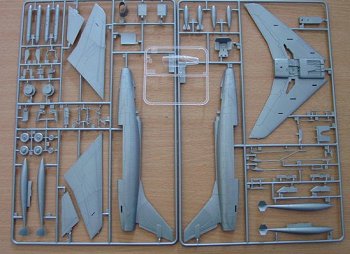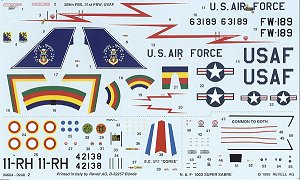
|
KIT # |
04604 |
|
PRICE: |
$12.99 SRP when new |
|
DECALS: |
Two aircraft |
|
REVIEWER: |
Scott Van Aken |
|
NOTES: |
Reboxed Italeri kit |

|
HISTORY |
The North American F-100 Super Sabre was an American supersonic jet fighter aircraft that served with the United States Air Force (USAF) from 1954 to 1971 and with the Air National Guard (ANG) until 1979. The first of the Century Series of USAF jet fighters, it was the first USAF fighter capable of supersonic speed in level flight. The F-100 was originally designed by North American Aviation as a higher performance follow-on to the F-86 Sabre air superiority fighter.
Adapted as a fighter bomber, the F-100 was supplanted by the Mach two class F-105 Thunderchief for strike missions over North Vietnam. The F-100 flew extensively over South Vietnam as the air force's primary close air support jet until being replaced by the more efficient subsonic LTV A-7 Corsair II. The F-100 also served in other NATO air forces and with other U.S. allies. In its later life, it was often referred to as the Hun, a shortened version of "one hundred".
While the Super Sabre really never was all that good as an air superiority fighter in the classic sense, it was a good interceptor and excelled as a fighter bomber.
|
THE KIT |
 This
kit is not new, being a 1999 reboxing of Italeri's F-100D. While one may
initially think that this is a reboxed ESCI kit, it is not. The sprue layout is
quite different and this kit offers items in it that were not part of the ESCI
boxing. It is influenced by the ESCI kit only in that they are both F-100Ds and
there are only so many ways to tool kits.
This
kit is not new, being a 1999 reboxing of Italeri's F-100D. While one may
initially think that this is a reboxed ESCI kit, it is not. The sprue layout is
quite different and this kit offers items in it that were not part of the ESCI
boxing. It is influenced by the ESCI kit only in that they are both F-100Ds and
there are only so many ways to tool kits.
First off, the detail is nicely engraved, and offers several options. The cockpit consists of the tub, three piece seat, control stick and instrument panel. There is detail on the panels. I would have liked a decal for the panels rather than raised circles, but one is not provided.
The kit has a separate nose gear well that is trapped between the fuselage halves. The instructions state 20 grams of weight and while that seems a bit much, perhaps it is all needed. Like the ESCI kit, the intake is rather shallow as is the exhaust. Both the original burner can and the F-102 can retrofitted to the F-100 later in life are included. Main gear well detail is provided in the one piece lower wing center section. For some reason, all the rather large slots for the wing pylons are already opened. I would prefer they not be and let the builder make that choice. In like with other F-100 kits, the lower nose gun insert is a separate piece. One can pose the speed brake lowered, which is good as this normally bled down after the power was removed.
Landing gear are nicely done and the main wheels are two pieces. The kit is not designed to be built gear up, though the modeler could do so with a bit of effort. For things under wings we have two large fuel tanks, a pair of M117 bombs and a pair of rocket pods with the aerodynamic covers. At least I think they are rocket pods and not fuel tanks. No missiles are included. One is offered the later bent refueling probe and the long pitot tube is a single piece that attaches to the lower intake. There is one major glitch on this kit. For some reason, the mold makers added an additional frame line near the rear of the one piece canopy. This will need to be sanded off and the clarity returned to the canopy.
 Instructions
are Revell's newsprint quality with only Revell paints referenced. There are two
markings options. One is the very colorful aircraft from the 31st FBW during a
weapons meet. The other is a French plane from EC 2/11 'Corse' in 1972. Both of
these markings options will use the original burner can. Decals are nicely
printed and matte. For those seeking something else, there are plenty of
aftermarket decals to choose from.
Instructions
are Revell's newsprint quality with only Revell paints referenced. There are two
markings options. One is the very colorful aircraft from the 31st FBW during a
weapons meet. The other is a French plane from EC 2/11 'Corse' in 1972. Both of
these markings options will use the original burner can. Decals are nicely
printed and matte. For those seeking something else, there are plenty of
aftermarket decals to choose from.
|
CONCLUSIONS |
Once one finishes gnashing teeth over the canopy glitch and the already open pylon holes, one is left with a very nice F-100D kit. It has enough bits and pieces to do an ANG plane and while it would have been nice to also have missiles, considering that it spent most of its war career dropping things, that is not such a bad deal. This kit is usually easy to find from the 'used kit' market.
|
REFERENCES |
https://en.wikipedia.org/wiki/North_American_F-100_Super_Sabre
August 2015
If you would like your product reviewed fairly and fairly quickly, please contact the editor or see other details in the Note to Contributors.